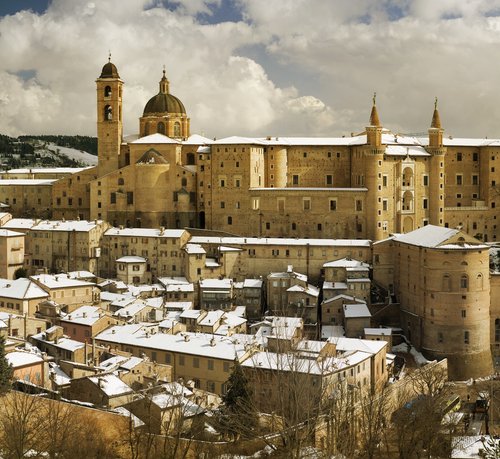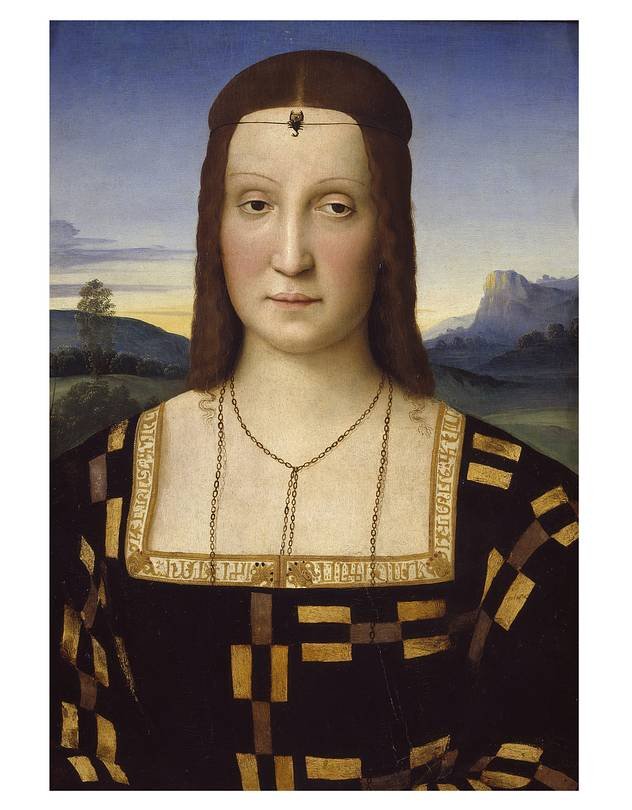The Ducal Palace of Urbino and the House of Montefeltro
The Ducal Palace in Urbino
One of the pearls of Renaissance Italy is the picturesque city of Urbino with the grandiose ducal palace which dominates it and which was the seat of the Montefeltro family.
This palace holds a special place in the history of European architecture for various reasons. Federico II da Montefeltro was the duke who in 1454 commissioned the redesign and enlargement of a previous and much smaller palace. At the time Federico was already famous, and his reputation was that of an undefeated commander, a condottiero, who fought alongside other Italian lords and even the pope. A few portraits show him always in profile and much has been written about his very unusual nose, which seems to have been cut off at its bridge. Was this a consequence of a battle wound? Well, indirectly .... It is now thought that he had lost his right eye in a battle and that he had the bridge of his nose cut off so that he could still have a view at 180 degrees...
Federico II da Montefeltro, Piero della Francesca, 1472
Federico II da Montefeltro
However, Federico was so much more than a man-at-war and a brilliant strategist. He was both educated and a patron of the arts. He was in fact, a culture vulture, always thirsty for knowledge - all kinds of knowledge. He had enlarged the Montefeltro library from a hundred volumes to over nine hundred. These were all manuscripts, all beautifully illustrated and precious. Some were in Latin, some in Greek and a few in Arabic and Hebrew. The collection is still intact and is now kept in the Vatican Museums.
When Federico became duke of Urbino the duchy was economically depressed and the city quite insignificant. In the forty years of his government Federico transformed Urbino into one of the most important cultural and artistic centres of Europe, on a par with Florence and Padua.
The Palace and its balconies
The palace that Federico commissioned was totally different from all other castles and palaces of the time. Think for example of Palazzo Vecchio in Florence, it is almost a fortress. The palace of Urbino has no fortifications and no defence system, it is simply a grandiose residence. So the message that Federico wanted to transmit to his contemporaries was that he was a powerful and undefeated leader and that he didn't fear attacks from anyone.
As a matter of fact, the palace of Urbino has three large balconies, which open onto the valley below. This was practically revolutionary and the first time balconies appear in medieval Italy. Two of the balconies are surrounded by columns which give them the appearance of triumphal arches. Federico was very much aware of how successful he had been.
Unfortunately, this can't be said of his son Guidobaldo, who inherited the Montefeltro duchy at Federico's death.
Guidobaldo da Montefeltro, Raphael 1507
Guidobaldo da Montefeltro
Guidobaldo throughout his life was neither in good health nor very successful. In 1496 he was taken prisoner by the Orsini family and freed the following year and in 1502 he was forced to flee Urbino to escape the army of Cesare Borgia.
On the 11th February 1488 Guidobaldo had married Elisabetta Gonzaga, who was one of the daughters of the powerful Duke of Mantua. However, the couple never had children and eventually adopted a nephew, who, however, belonged to the Della Rovere dynasty. So this was the end of the House of Montefeltro. It was actually said that the marriage was never even consummated, despite a letter sent by one of Elisabetta's advisors to Mantua two months after the wedding. The letter contained the information that finally on the 19th April bride and bridegroom had slept together. The excuse for the delay was that they had consulted an astrologer who had advised that April or beginning of May were auspicious times for their first night of procreation!
Between 1504 and 1505 Raphael executed the portrait of Elisabetta here below and the image is rather unusual and telling.
Duchess Elisabetta da Montefeltro, Raphael 1505
Elisabetta's Portrait
In the portrait Elisabetta wears what seems to be a very expensive black dress decorated with gold and silver rectangles. Her dress neckline is square and all around it is an edging in gold with strange characters. The characters seem to be Arabic but they are not. In fact, they are meaningless. At the time anything that came from the Orient was considered exotic and costly, so it was common for tailors to decorate expensive clothes with fake arabic letters in order to suggest luxury.
Elisabetta has a melancholy (disappointed possibly ..?) expression and her eyes are cast down. Her brown hair is parted in the middle and on her forehead is a small amulet in the shape of a scorpion which holds a stone in its claws. So how should we read this portrait? The colours black and gold are those of the House of Montefeltro and the scorpion is a symbol of passion and fertility. Elisabetta wasn't born under the sign of Scorpio and the jury is still out as to why she wore a scorpion. The general consensus among scholars however is that it was an amulet or a talisman and she wore it as a lucky charm to ingratiate the passion and fertility that her marriage lacked.
Astrology and Scorpions
In the medieval and Renaissance ages Scorpions were also thought to heal patients from poisoning and cool down fevers. Astrology was considered very much a science and no difference was made between astrology and astronomy.
At the Victoria & Albert Museum, alas not on display, is a ring which originates from the Italian peninsula and this ring has a stone engraved with a scorpion. The stone dates to the 1st or 2nd century B.C. but the mount dates to the 15th century, so exactly the same period as Elisabetta's amulet.
Guidobaldo and Elisabetta seem to have been very fond of each another and she refused to leave Urbino when he was taken prisoner. Even her family advised her a few times to return to Mantua but she never left Urbino or Fossombrone where they often resided.
Although Elisabetta in her private life did not succeed in having children and heirs, in her public life she certainly met recognition and success as a patron of the arts. She held a very refined and cultured court and she encouraged artists and poets to come and stay in Urbino. The writer Baldassare Castiglione lived at her court and wrote his Courtesy Book il Cortigiano, or the Courtier, on the basis of his conversations with Elisabetta. The book describes how a courtier should behave both in terms of etiquette and in terms of morality.
Other artists who resided at the court of Urbino were the architects Donato Bramante, Luciano Laurana and Giovan Battista Alberti; the painters Piero della Francesca and Paolo Uccello, the mathematician Luca Pacioli and the Flemish painters Pedro Barruguete and Giusto di Gand (Joos van Wassenhove). It is therefore no surprise that a painter of the calibre of Raphael was born in Urbino…
Have you visited Urbino yet?! You will not be disappointed ….






